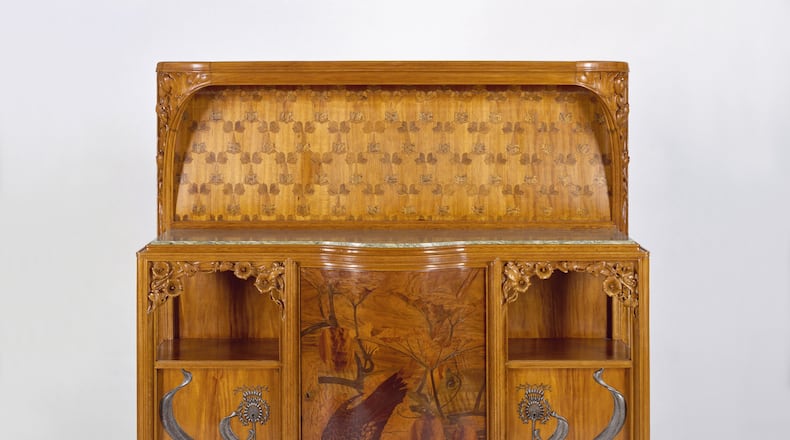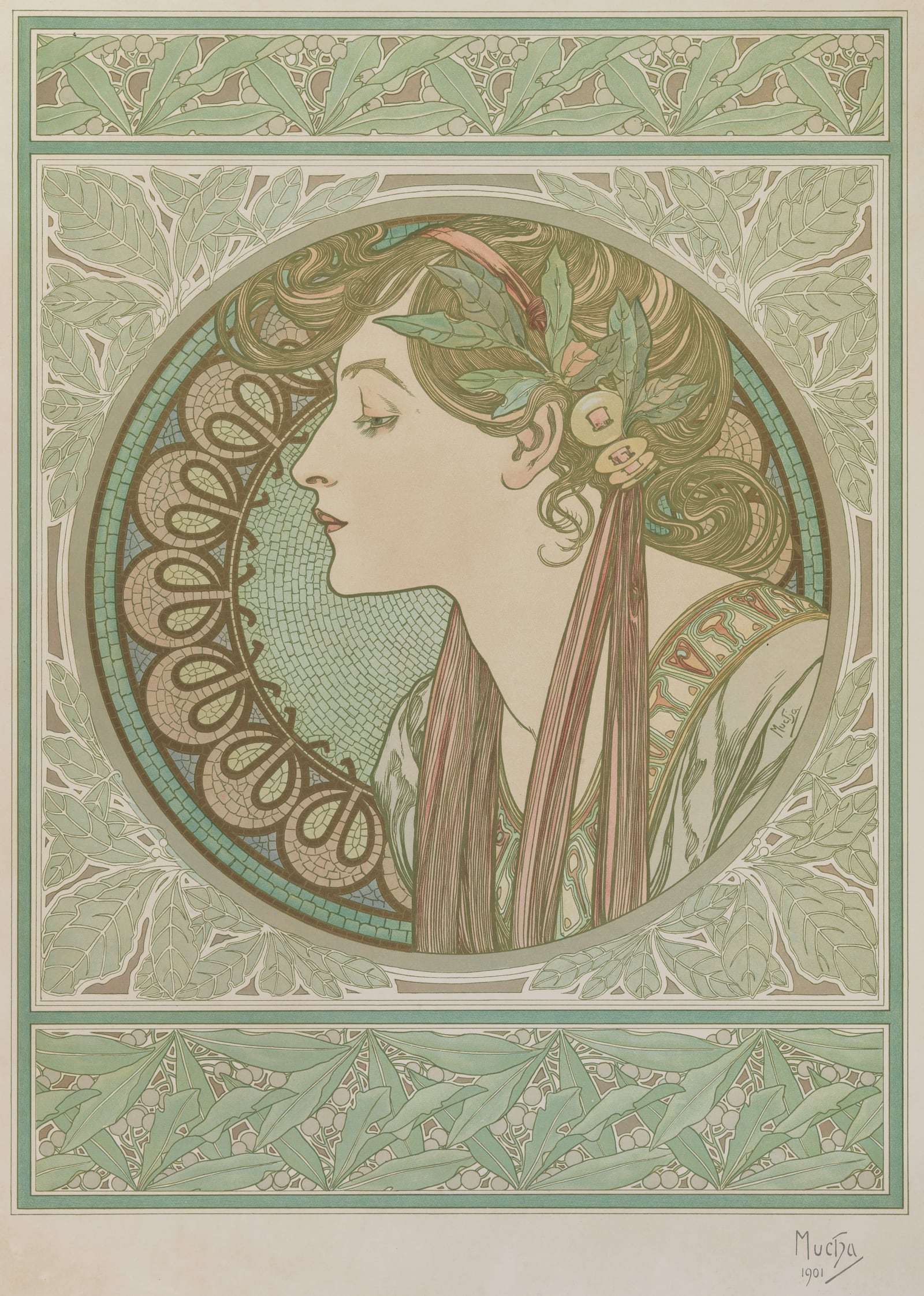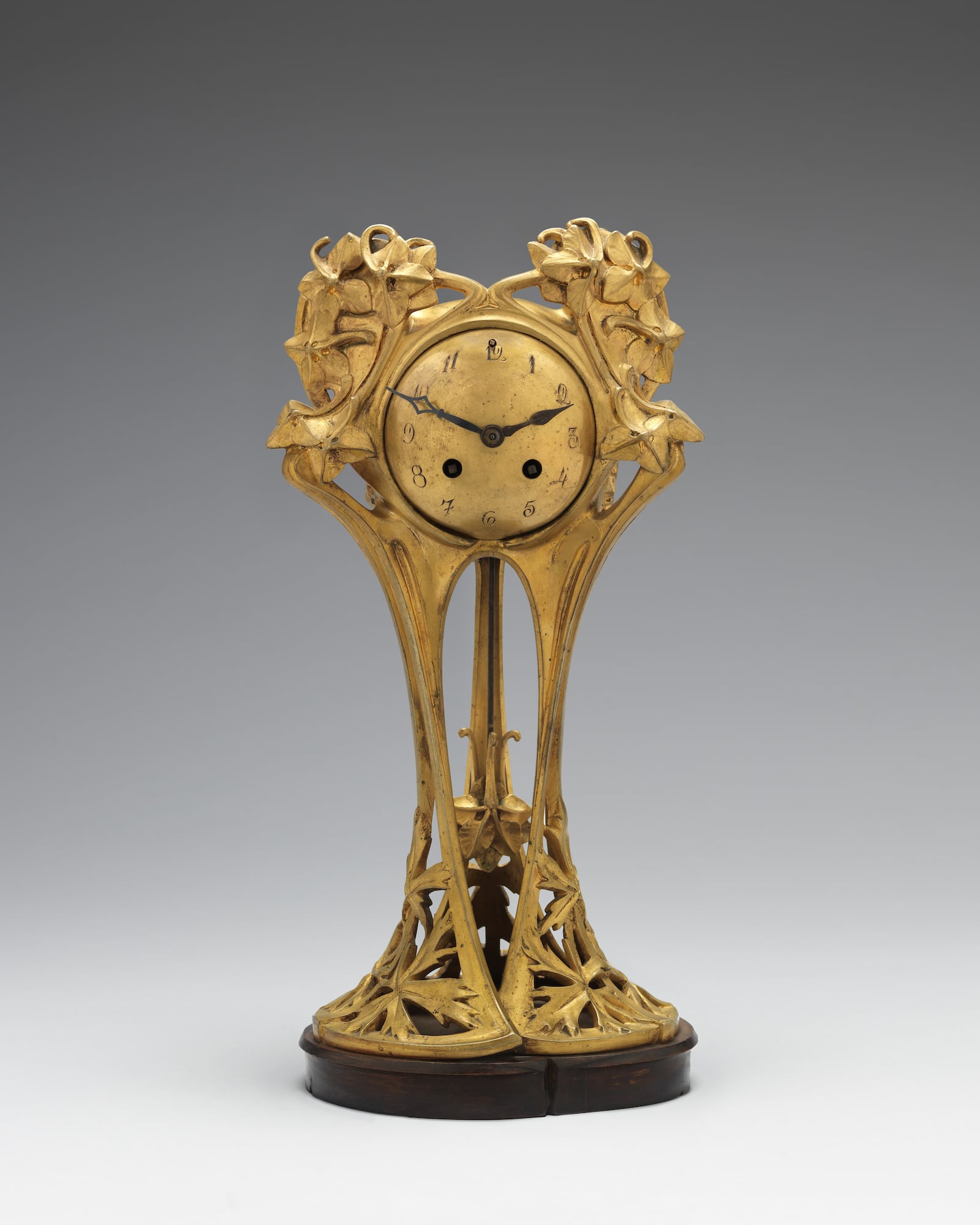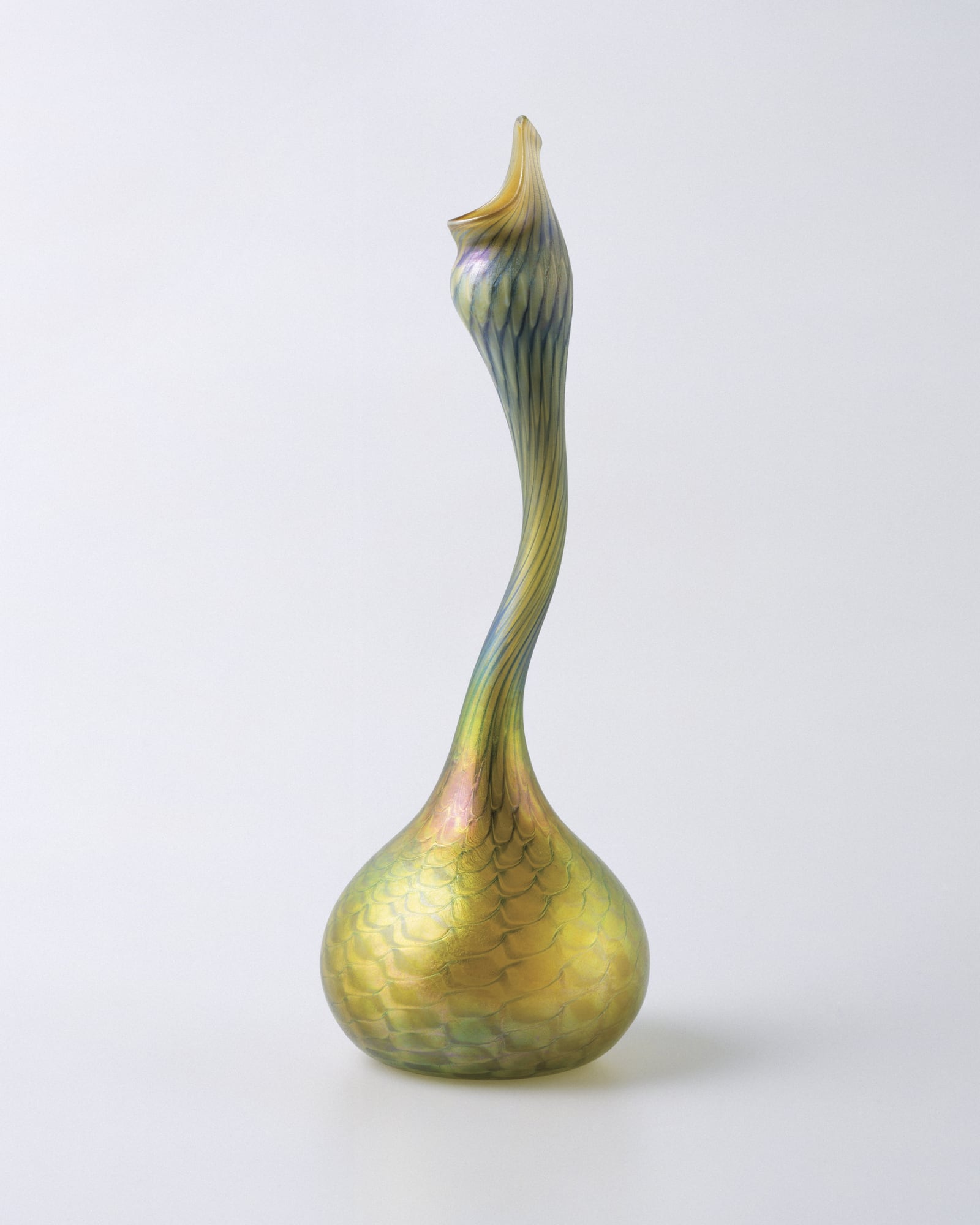Visitors will also learn about the influence Japanese art, especially Japanese printmaking, had on art in America and Europe. Japanese art provided a new aesthetic that routinely emphasized natural motifs.
“The Triumph of Nature: Art Nouveau from the Chrysler Museum of Art,” will be on display through Jan. 11.
We asked head curator Jerry Smith what visitors can expect to see.
QUESTION: What is Art Nouveau?
Answer: Art Nouveau, which is French for “New Art,” was an art movement in America and Europe that lasted from about 1880 to the 1910s. It is primarily found in the applied arts, in decorative items like vases, clocks and silver work, as well as in furniture and printmaking. As a style, it’s recognized for rich and sensuous designs, delicate patterns and shapes found in and informed by nature, with lots of curvilinear lines and whiplash curves.
Q: So it was a short-lived movement?
A: Just a couple of decades, from the 1880s to World War I, which lasted from 1914 to 1918. The work was finely crafted and prices far exceeded what most people could afford, so it was admired but we can’t even say it was ever truly popular. And by the wars end, furnishings and decorative objects featuring soft, flowing lines, fussy attention to minute details in praise of nature suddenly seemed awkward and out of place when juxtaposed against the devastation of war.
Art Nouveau was quickly replaced by the industrial and geometric-inspired style of hard-edged designs known as Art Deco. To see that progress, a few examples of Art Deco are included at the end of the exhibition.
Q: Other than the Mucha print exhibit, what other Art Nouveau exhibitions have been at the DAI in recent years?
A: We had “Maker and Muse: Women and Early 20th-Century Jewelry” in 2019–2020. Most recently, in 2023–2024, we featured “Toulouse-Lautrec: The Birth of Modern Paris,” that showed how the Post Impressionist artist was also associated with Art Nouveau through his cabaret posters.
Q: Why do people love those exhibitions?
A: The turn of the 20th century was a transformative period in the arts, from Impressionism to Modernism to Art Deco and beyond, and that period remains extremely popular with art lovers.
Q: How did you hear about the exhibition?
A: This is a traveling exhibition put together by the non-profit exhibitions organization International Art & Artists. We have worked with them on other shows and because of that relationship, we were one of the first museums they spoke to when they were in the early planning stages. We signed the contract in 2021. The only thing we really insisted on was to be the exclusive venue in Ohio, which we are.
Q: Is the artwork from one collector?
A: The works themselves are part of the collection of the Chrysler Museum of Art, Norfolk, Virginia. All but a few of the items on view were originally collected by a single individual, Walter Chrysler, Jr., son of the Chrysler auto-maker. He was collecting Art Nouveau in the 1960s, when Pop Art and Minimalism were in vogue, and fussy and beautiful glass and furniture items were considered outdated and old fashioned. This means he was buying when the work wasn’t really popular and was relatively affordable. He was buying entire collections at times and amassed a great body of work, which he ultimately gifted to the museum bearing his family name.
Q: Were these items ever used?
A: Many of the works would have been used, although I suspect many of the glass and porcelain vases are so delicate and precious that they would have been used more for display than actually holding flowers. However, large furniture items, even with their amazing inlay designs and patterns, would likely have been used as intended.
Credit: Ed Pollard
Credit: Ed Pollard
Q: What are two of your favorite items?
A: Always a difficult question, because there are so many extraordinary things. However, one vase that stands out to me is a small one that many might overlook. It is a blown glass with cameo glass decoration “Waterlily Vase, 1900. “ Made by the Sèvres Porcelain Manufacturer, it is unusual because the opening is long and narrow, a rectangular shape that might hold a row of flowers.
I also like a large, silver ”Martelé Centerpiece" by the Gorham Manufacturing Company, with different levels to hold delicate pastries, perhaps, or petite finger sandwiches, and maybe punch in the top portion. It is large and bold, a true statement piece that would not be practical in the average home. "Martelé “means hammered, so it is a hammered silver work.
Q: Can you pick a few more items of special interest?
A: The blown glass Tiffany furnaces with swirling design and long, narrow neck is a fabulous example of Tiffany glass. Others:
- A color lithograph by Alphonse Mucha entitled “Ivy,” epitomizes Art Nouveau printmaking. The ivy vine within a woman’s hair and the exacting, natural designs that make-up the border, are quintessential Art Nouveau.
- A fruitwood and marble Buffet by Louis Majorelle is rich in detail and combines different woods, inlay wood designs along with metal plant motifs on the buffet is exquisite.
- There’s a large silver trophy by Tiffany & Company given for yachting that is so big and over-the-top, I just love it. It features Tritons blasting horns among gusting winds as they emerge from crashing waves. This is far from your typical sporting award.
Q: So it was a short-lived movement?
A: Just a couple of decades, from the 1880s to World War I, which lasted from 1914 to 1918. The work was finely crafted and prices far exceeded what most people could afford, so it was admired but we can’t even say it was ever truly popular. And by the wars end, furnishings and decorative objects featuring soft, flowing lines, fussy attention to minute details in praise of nature suddenly seemed awkward and out of place when juxtaposed against the devastation of war. Art Nouveau was quickly replaced by the industrial and geometric-inspired style of hard-edged designs known as Art Deco. To see that progress, a few examples of Art Deco are included at the end of the exhibition.
Q: Are there any famous artists in the exhibition?
A: Louis Comfort Tiffany is likely the best known artist, since most people are aware of Tiffany glass and Tiffany lamps. Alphonse Mucha is another big name, and we have a couple of his prints in the exhibition. Otherwise, there are names for people who know about glass and furniture, artists like Émile Gallé and Louis Majorelle.
Q: Anything interactive? Anything for kids?
A: We have a space for family activities part way through the exhibition, then a selfie-photo space at the end. Kids will be fascinated by the various objects and we also have some fun coloring pages available at the front desk. We have guided tours on various Saturdays and a Mosaic-making workshop with local artist Jes McMillan.
Q: Other than the exhibition, does the DAI have examples of Art Nouveau on view?
A: The first item the DAI collected in 1919, Harriet Frishmuth’s “Joy of the Waters,” with its depiction of a woman springing from nature in what was originally a fountain, is an example of Art Nouveau. We also have the beautiful glasswork by Tiffany on view as well as a “Dragonfly” Tiffany lamp. In time for the exhibition, we also installed a recent gift of an Art Nouveau stained-glass and wood cabinet. It is gorgeous.
Q: There are a lot of huge pieces of furniture in the exhibition. How did you get them into the gallery?
A: It is a big exhibition that came to us in three full-sized tractor trailer trucks. It was exciting to see each item as we opened the cases, and see how carefully packed each item is. Some of the furniture is large and we had to handle it delicately, with a couple of items just barely, within a couple of inches, of making it through our gallery doors.
Q: What do you hope people will take away from visiting the exhibition?
A: Our hope is people enjoy seeing these incredible artworks, and get a better understanding of what Art Nouveau was. Look at the works and see what you like most. Is it the glass work, the furniture, the jewelry or silverwork? It is the type of show that people can learn about the art, but also about their own likes and dislikes. See if you can pick out your own favorite item in the show, or in a specific case. This approach makes for a fun discussion among couples and families.
HOW TO GO
What: “The Triumph of Nature: Art Nouveau from the Chrysler Museum of Art”
Where: Dayton Art Institute, 456 Belmonte Park North, Dayton
When: 11 a.m.-5 p.m. Wednesday, Friday and Saturday; noon-5 p.m. Sunday, 11 a.m.-8 p.m. Thursday
Admission: $15 adults; $10 seniors (60+), active military and groups (10 or more); $5 students (18+ w/ID) and youth (ages 7–17); and free for children (ages 6 & younger). Admission is free for museum members
More online: daytonartinstitute.org
RELATED PROGRAMMING
- Saturday Guided Tours from 1-2 p.m. on Nov. 22 and 29 and Dec. 13 and 27
- A two-session mosaic workshop from 6-8 p.m. Nov. 13 and 20 with Jes McMillan, owner of the Mosaic Institute of Dayton. Cost is $60 for members and $65 for non-members. Ages 18 and older
About the Author





